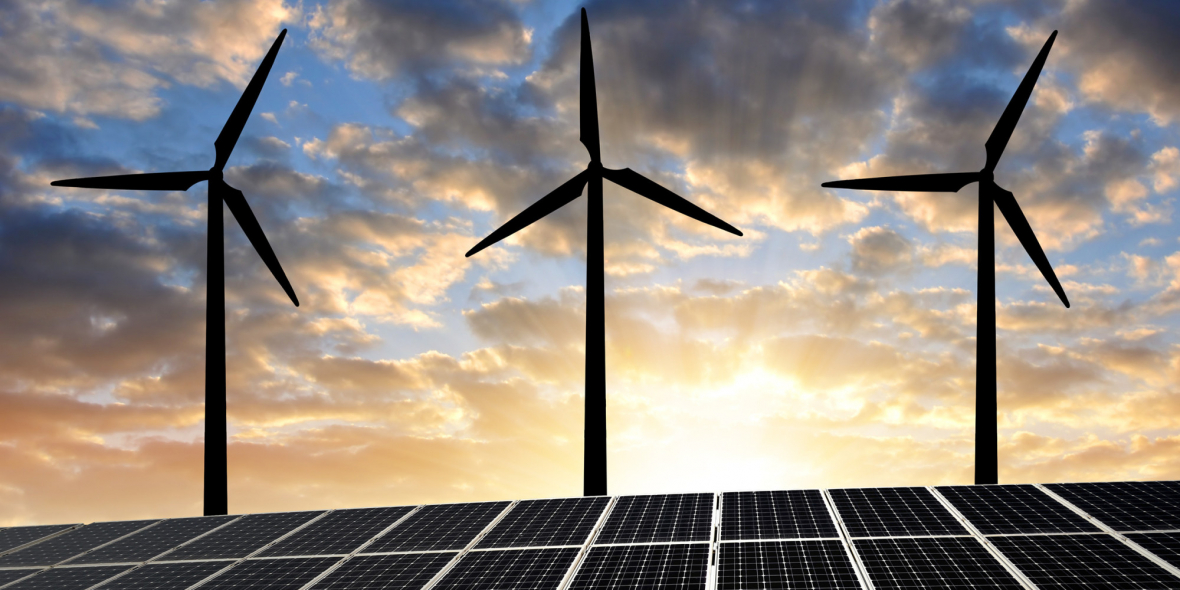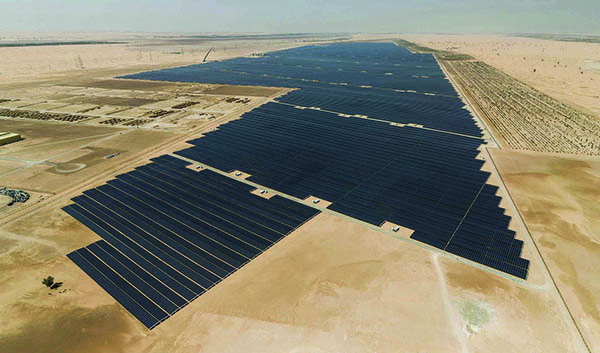







With nearly $76bn worth of renewable energy projects planned or underway, the Middle East and North Africa (Mena) region are steadily increasing the share of renewables in their energy mix.
Energy supply in this region has been traditionally focused on the generation of electricity from oil and gas-fired power stations. The abundance of low-cost hydrocarbon fuels have made conventional thermal power the main economic source of energy.
As a result, renewable and alternate fuel sources have largely remained underdeveloped in the MENA region.
However, a growing drive to maximize returns on the region’s hydrocarbons assets and reduce carbon emissions has seen a surge in renewable energy investments in recent years. Moreover, led by the UAE and Saudi Arabia, the Middle East has play a significant role in renewable energy.
Falling costs, rising targets
Certain challenges impede the successful adoption of renewable energy across the region, including high adoption costs, inconsistent and unpredictable amount of electricity generation, and instability caused by uncontrollable conditions such as erratic weather. These come in addition to the political instability that has rocked some countries in the region.
However, boosting power supply and production capacity is a priority for all governments in the region, as they aim to meet growing domestic demand. By meeting their power needs through renewable sources, the governments can optimize hydrocarbons for export to finance the economy.
|
COUNTRY |
TARGET ENERGY SHARE |
|
Algeria |
27% by 2030 |
|
Bahrain |
10% by 2030 |
|
Egypt |
44% by 2030 |
|
Iran |
5% by 2020 |
|
Iraq |
4% by 2030 |
|
Jordan |
20% by 2025 |
|
Kuwait |
15% by 2030 |
|
Lebanon |
30% by 2030 |
|
Libya |
10% by 2025 |
|
Morocco |
52% by 2030 |
|
Oman |
30% by 2030 |
|
Qatar |
20% by 2030 |
|
Saudi Arabia |
30% by 2030 |
|
Syria |
30% by 2030 |
|
Tunisia |
30% by 2050 |
|
UAE |
44% by 2030 |
|
Yemen |
15% by 2025 |
Recent years have seen a sharp fall in the cost of solar and wind technologies, spurred by growing investments in research and development, and the entry of private firms in the game, which has increased competitiveness and driven down costs.
According to the International Renewable Energy Agency (Irena), solar PV module prices have fallen by around 80 per cent since the end of 2009, while wind turbine prices have fallen by 30-40 per cent. Moreover, the cost of electricity from bioenergy, hydropower, and geothermal, onshore and offshore wind was within the range of fossil fuel-fired power generation costs between 2010 and 2018.
Solar Energy Rapid Growth

it expects that at least $15 billion of solar power projects will enter operation in the region in the next five years.
According to a report released earlier this year from the International Renewable Energy Agency (IRENA), MESIA has estimated the region’s solar power market is worth more than $20 billion. Solar photovoltaic (PV) technology is now “the most competitive form of power generation” in the Gulf region. The IRENA report shows that Gulf Cooperation Council (GCC) countries, which include the United Arab Emirates (UAE) and Saudi Arabia, plan to install almost 7 GW of new power generation capacity from renewable sources by the early 2020s.
In early 2020, Saudi Arabia advanced to a second phase of its solar procurement plan, opening bidding for seven projects totaling more than 1.5 GW of capacity. Oman has begun the procurement process for the rollout of at least 1 GW of residential solar generation. Reports earlier this year said Algeria had announced tenders for 2 GW of solar generation.
Mina Mesbahi, a research analyst at Solarplaza International B.V., a Rotterdam, Netherlands-based group that organizes solar PV events worldwide, told the Saudi Gazette English-language newspaper that the UAE is the leading market with solar projects either operating or in development. “The top five markets in the MENA region with the largest operational and in-the-pipeline solar projects include the UAE [58%], Egypt [23%], Jordan [10%], and Morocco [6%],” along with Iran (3%). “Almost all the countries in this region experience an all year-round sunshine, providing breeding grounds for solar development. Accounting for almost 3 GW of operational capacity, solar seems to only loom large for MENA,” Mesbahi said.
MESIA has said that the MENA region is expected to need at least 267 GW of additional power generation capacity by 2030, an increase of 66% from today’s generation capacity level. A Solarplaza International research team recently compiled a list of the region’s largest solar power projects, led by the 1,177-MW Noor Abu Dhabi (Figure 1) project in the UAE, which came online in late June. Second on the list is the 200-MW second phase of the Mohammed bin Rashid Al Maktoum Solar Park in the UAE (Editor’s note: The third phase of this project, an 800-MW installation, is scheduled to come online in 2020. The fourth phase of the project has a generation capacity of 700 MW, and was scheduled to be commissioned in phases beginning next year).
Other large projects include the 186-MW Benban Solar Complex, and the 166.5-MW Benban Solar Park in Aswan, both in Egypt. Mesbahi’s group in a recent white paper noted the challenges with operating solar facilities in the region. “The dusty desert conditions make for challenging and risky operations,” the report shows that solar farms in much of the region are vulnerable to sandstorms that can scour or obscure solar panels, leaving them in need of cleaning. “Good news is that these risks and challenges can be overcome given the advancements in solar technology. After all, if the panels are covered with dust and sand, they are not receiving as many rays of sunlight. Additionally, sand and the UV [ultraviolet] light have an adverse effect on the performance of the panels and cause backsheet degradation.”
Saudi Arabia, meanwhile, on Sept. 29th announced it has opened applications for loans from a 105 billion riyal ($28 billion) Saudi Industrial Development Fund, known as Mutjadeda. The program will provide loans of as much as 1.2 billion riyals ($320 million) to companies involved in development of renewable energy projects, as the country tries to diversify its energy industry away from a reliance on crude oil. The fund also is available for financing of projects for renewable energy from other industrial sectors. “Whether you’re in manufacturing, agriculture or retail, if you want to deploy renewable energy, we will finance it,” Ibrahim Almojel, the fund’s director general, said in a statement. “For renewables to be adopted in the kingdom, we need to support it.”
The fund was first created more than 40 years ago, but it is being revamped as part of Crown Prince Mohammed bin Salman’s plan for life after oil in Saudi Arabia, a program called Vision 2030. The Saudi government in January raised the fund’s capital resources by about 60%.
In 2020, The World Bank announced that “Primary energy demand in the [Middle East] region is expected to continue to rise at an annual rate of 1.9 percent through 2035,” and several countries have begun embracing solar and wind as a way to diversify their power generation mixes, which are heavily dependent on natural gas and oil.

Figure 1: MW Noor Abu Dhabi project
Saudi Arabia also is exporting its solar PV technology; Saudi-based ACWA Power in September was awarded a contract to develop two projects, with total generation capacity of 250 MW, in Ethiopia. Upendra Tripathy, head of the Delhi, India-based International Solar Alliance (ISA), a group of 122 “sun-rich” countries, welcomed Saudi Arabia as a member in early 2020, telling Arab News, “The decades of experience in energy policy, infrastructure, investment and financing that Saudi Arabia will bring on board will be incredibly valuable for ISA members. This will help member countries to promote solar-energy deployment and implement the Paris [climate] accord. As a prominent member of OPEC [Organization of Petroleum Exporting Countries], Saudi Arabia has always played a major role in global energy markets. The Saudi government is sending a clear message to the global community that it can play a prominent role in the future of solar energy.”
With more than 25 years of experience in consulting, we are proud to serve our clients with best quality. Our primary focus in this industry is to supply materials and equipment to clients. Our goal is to be one the strongest consulting companies within service, support.